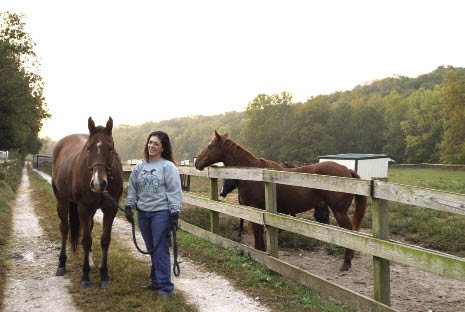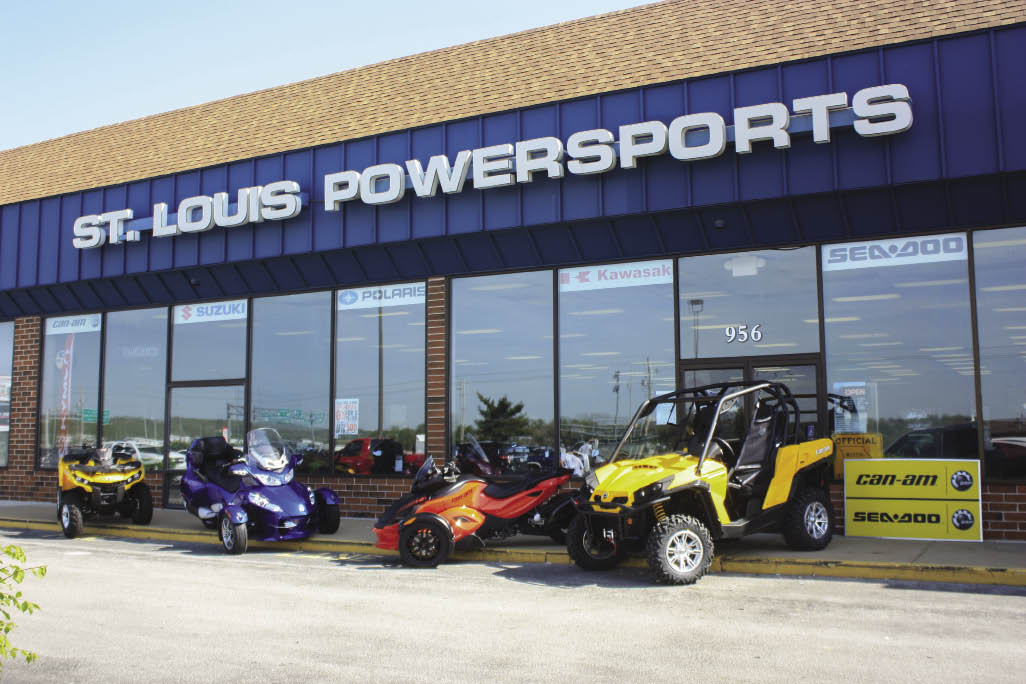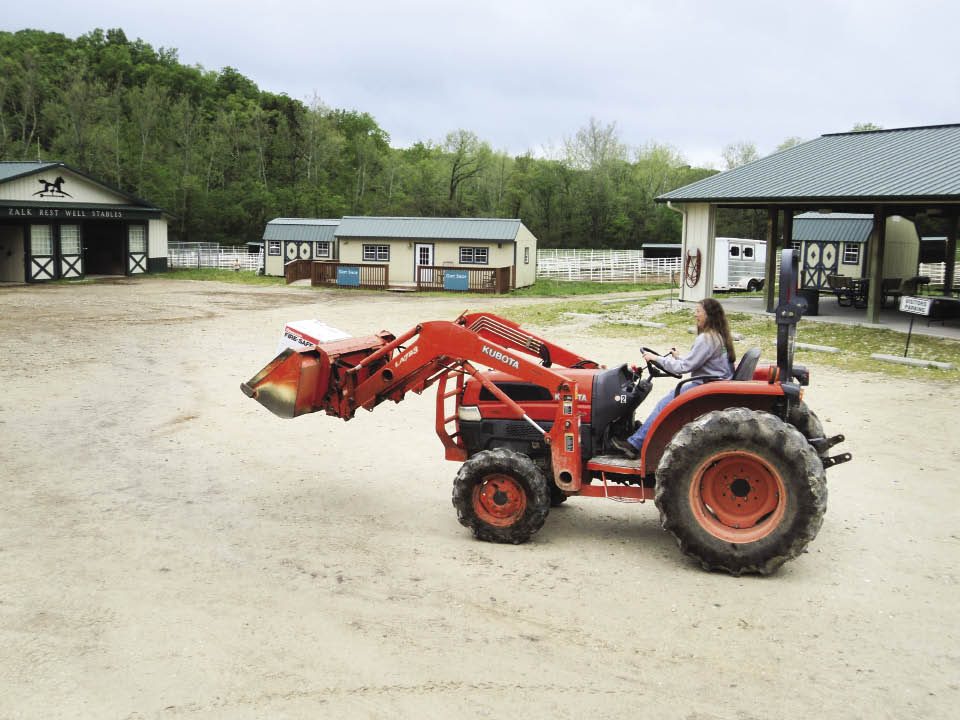Longmeadow Rescue Ranch worked with Schaeperkoetter Sales & Service on recent equipment purchases. The dealership's responsiveness and knowledge earned them a Kubota tractor sale.
Horses, chickens, ducks, geese, cattle, llamas, goats, sheep, pigs and 165 acres: That's the caretaking and grounds maintenance task for the team at Longmeadow Rescue Ranch in Union, Mo. The ranch is part of the Humane Society of Missouri and can care for more than 350 abused and neglected animals.
"Animals come to us from desperate situations. One horse would not have lived if we had not gotten there that night. We have the drive and work ethic to take care of these animals. There are good days and bad days and the work is difficult. The number of animals may fluctuate, but each one always gets the best level of care," says Amanda Mullen, ranch director.
Longmeadow is one of the most comprehensive horse and farm animal rescue, rehabilitation and adoption centers in the country. Animals come to them through animal cruelty investigators and law enforcement as victims of abuse or neglect and from owners who can no longer care for their animals. Here's how the team relies on rural lifestyle equipment to care for these animals and help them find new homes.
25 Years of Animal Care
Longmeadow Rescue Ranch, once known as Packwood Longmeadow Farm, was purchased in 1988. The purchase was part of a bequest from George Packwood, Jr., an entrepreneur who invented an industrial soap and soap dispenser in the 1920s. He ultimately sold the business to Calgon in the 1950s. He once said: "In the world of business, if you perfect something good, you can get up on the housetop and flap your wings and crow about it."

Meet Longmeadow Rescue Ranch
Mission: Longmeadow Rescue Ranch is one of the most comprehensive horse and farm animal rescue, rehabilitation and adoption centers in the country. The facility can house more than 350 animals. Its slogan: "We believe in second chances."
Property: 165 acres in Union, Mo. About 55 acres is pasture, another 50 acres has smaller paddocks and buildings and the rest is native woods.
Equipment: Bobcat 763 with backhoe, buckets and pallet fork; Craftsman lawn tractor; Delta harrow; Frontier and Mill Creek manure spreaders; three Kubota tractors (3430, 3830 and 3940) and front-end loaders; Land Pride blades, rotary cutter, finish mower, auger and spreader attachments; Polaris Ranger; Stihl string trimmer and chainsaws.
Video: Watch "A Day at Longmeadow Rescue Ranch,"
www.longmeadowrescueranch.org
Today, the ranch is supported by individual and corporate donations. It is not affiliated with any other national animal welfare organization. Over the years, the ranch has developed about 55 acres of pasture, another 50 acres or so for buildings and smaller paddocks, while keeping the rest native woods.
The ranch includes four horse barns. One is used as a learning center, another as a quarantine barn for sicker horses and two others for general equine housing. Two other barns are used for smaller animals and one facility stores hay.
Equipment That's Ready
Linda Chapman, customer service specialist and lead ranch assistant, works with the ranch's 11 employees and coordinates its volunteers. More than 150 people are on the volunteer list, with some coming in every day. She says there is no typical day, but it generally starts at 7 a.m. with feeding and ends at 9 p.m. with the caretaker doing final barn and pasture checks. Chapman refers to the routine as "divide and conquer."
"Everyone is assigned their own barn areas and we break down into smaller groups," Chapman says.
Throughout the day, the team feeds, waters, moves animals out to pasture and back in for care, administers medicine, walks those animals who need extra help, trims hooves and checks weights. They also repair fences, maintain pastures and the front visitor areas and attend to the ongoing tasks of cleaning stalls and pens and keeping work areas clean and organized.
The ranch uses more than a dozen pieces of large equipment and attachments, along with many hand tools. It owns three Kubota tractors, 3430, 3830 and 3940 models. The 3830 and 3940 have loaders and are used for moving sawdust from the storage bins to the barn areas and spreading manure with its Frontier and Mill Creek manure spreaders. The Kubota 3430 is used with its Land Pride blades, rotary cutter, finish mower, auger and spreader attachments as well as a Delta harrow for arena maintenance.
The ranch's Bobcat 763 skid steer and its backhoe, bucket and pallet fork attachments also help with grounds care and moving hay, pallets of feed bags and other supplies.
Dealer Takeaways
• Be mindful that nonprofit organizations are spending donors' money to buy equipment. Help them make the most of it with attractive trade-in offers.
• Promote ease-of-use and reliability for equipment that will be used by many operators.
• Just because a customer has a limited budget doesn't mean they aren't ready to buy equipment.
A Polaris Ranger is utilized for moving people and supplies around the ranch and for small animal pens.
Stretching a Budget
Nonprofit organizations like Longmeadow Rescue Ranch often have limited budgets, but still need reliable equipment to accomplish their missions. Dealers who help them balance these priorities can earn customers.
John Konersmann, owner of St. Louis Power Sports, St. Louis, sold the ranch a Polaris Ranger 500 by offering a good trade-in deal for an older Kawasaki Mule that needed repairs.
"We shopped around for different deals and they gave us a good price and trade-in," says Amanda Mullen, ranch director.
The ranch uses the UTV every day for chores as well as to transport visitors.
"The Ranger has fuel injection so it's always ready to go. It's an easy vehicle for their volunteers to operate," Konersmann says.
A similar approach by Mark Schaeperkoetter, owner of Schaeperkoetter Sales & Service, earned his dealership a sale of a Kubota 3940 and Land Pride blade and auger. The ranch traded in an older Kubota. The dealership has locations in Mt. Sterling and Owensville, Mo.
"They had a limited budget and we went the distance to get them as much as we could for their budget," says Schaeperkoetter. "It was a mutually good deal. We got a used tractor out of the deal and somebody else is now running that dependable tractor. It's also good public relations when people see our Kubota equipment at Longmeadow events."

And, there's still more work to be done with Stihl trimmers and chain saws and a Craftsman lawn tractor for maintaining visitor areas.
Taking Care of Equipment
Mullen says well-kept buildings and grounds are important for several reasons.
"The money and materials donors give to us are treated as if they are our own. Although animals are our priority, clean and well-kept equipment reflects the level of care we give our animals and the value we place on our donors. Excellence in all we do is also evident to potential adopters. Achieving that excellence includes the proper equipment training for staff and specific volunteers," Mullen says.
"We really limit who uses the equipment. We don't let every employee use every piece of equipment and we carefully select the volunteers who are trained to use equipment. Some volunteers come in with Bobcat certification, which is very helpful knowing we have a qualified driver when we need one," says Chapman.
"Safety is also paramount, even when it's as simple as someone climbing into the Ranger. We make sure drivers always use a safety belt," Mullen says.
Although training is provided, Mullen says it's important that the vehicles are easy to use.
"Important considerations for our equipment are durability and being simple to use. Our staff is experienced with horses and farm animals but some may never have driven a tractor before they started working here. It's important for us to have equipment that's easy to use and maneuver," Mullen says.
Working with Dealers
Mullen explains how she worked with dealers to purchase their Polaris Ranger and the Kubota 3940. The ranch purchased the Ranger in 2011 from St. Louis Power Sports.
"We shopped around for different deals and they gave us a good price and trade-in," Mullen says. They traded in a Kawasaki Mule they had used for 6 years.
"The Ranger is handy because it's compact. We can pull it into the aisles of the barns and load up the bed with waste and take it to the compost area. We use it to move bales of hay, troughs and equipment. It's a lot easier to use than a pickup because the bed is lower," says Mullen. Other selling points were the bed capacity and electronic fuel injection for reliable starts in cold weather. The Ranger is also used for showing donors around the grounds.
Mullen turned to other users for advice before buying. "I looked online to see comments for different products. We were interested in trying something different," she says. (See the sidebar "Online Reviews Influence Rural Lifestylers" on page 50.)
The ranch's other recent purchase is the Kubota 3940 bought in 2011 from Schaeperkoetter Sales & Service, with locations in Mt. Sterling and Owensville, Mo.
"We had compared prices with another Kubota dealership. Because Schaeperkoetter gave us a better trade-in value, we were able to buy a blade and an auger. We knew we needed that other equipment and they helped us stretch the dollar as much as we could," Mullen says. A volunteer helped research options and Schaeperkoetter's customer service sealed the sale.
"They spent a lot of time talking about what we needed. They were quick to respond and found the tractor fast," says Mullen.
Watching Budget
The ranch's fiscal year runs from November 1 to October 31 and Mullen presents a budget in late summer for the board to approve. While equipment requests need to be included in that budget, she is able to make special requests.
"I have to keep an eye on the life of the equipment and if it might need more repairs. Because we are a non-profit, we do have budget constraints. I wish we could get a new tractor every 5 years," she says.
When it's time to trade in or purchase new, Mullen says she needs this from a dealer: "I'm looking for a dealer who is honest and can give us the best trade-in value. I want their best price - and their best advice, too. I'm spending donor monies and I need to get maximum value for every dollar we spend. Whatever I can save means more animals we can help."
Online Reviews Influence Rural Lifestylers
More than 36% of rural lifestylers say online reviews influence their purchase decisions, according to a recent study by Paulsen Marketing. More than half of those surveyed say the reviews have even more influence if the rural lifestyler either identifies with the person writing the comments or considers them an expert.

Sara Steever is Paulsen Marketing's vice president of digital services.
"Dealers are definitely seen as experts. Their expertise is something they can bring into that online community," says Sara Steever, Paulsen's vice president of digital services.
Steever says reviews happen formally, such as news stories that compare products, and informally, such as on websites like www.tractorybynet.com and even www.amazon.com. Consumers do submit reviews about extremely good or bad experiences, but generally they are either neutral or positive, she says. And, negative reviews can offer an opportunity.
"The thing one person thought was a negative could be a positive. For instance, one person might think a piece of equipment was too complicated, but an expert user might want those extra features."
Dealers can add their expertise to the discussion. What if the review is negative about the dealership?
"Hit it immediately with an apology, short of what might have legal ramifications. Then, ask to move the discussion offline and, in private, correct the situation," she says.
She says customer service is what really makes a difference in the purchase decision. Comments from the survey: "Rural lifestylers looking to buy a new tractor may rely on online reviews to help them during the awareness and consideration phase of the purchase process, but personal contact with a dealer is more likely to influence an actual purchase."






Post a comment
Report Abusive Comment